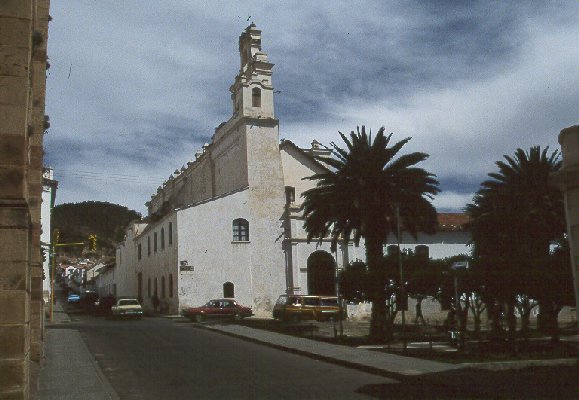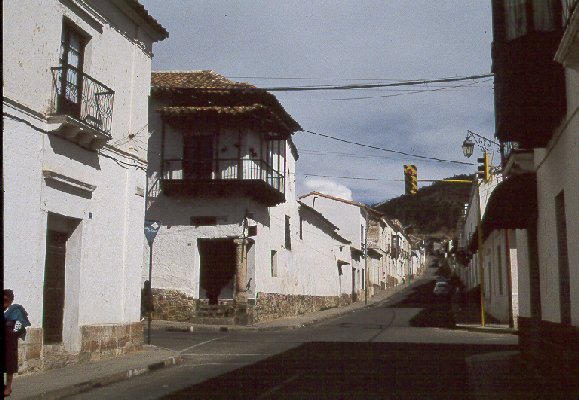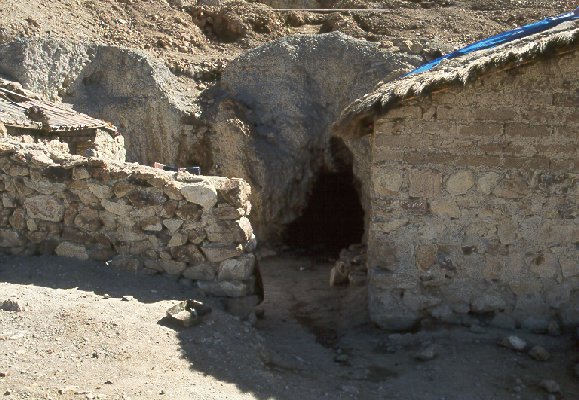
| Home Page of Paul Dalhoeven |

| Home Page of Paul Dalhoeven |
 Iíve been four times to Bolivia. The First time was in 1992, as part of a journey through Bolivia, a small part of Brazil, and Paraguay, for six weeks. The second time was in 1993, to marry my Bolivian better half. The third time in 1999 to show my newborn boy to his family, and in 2006 to show off with my second boy as well.
Iíve been four times to Bolivia. The First time was in 1992, as part of a journey through Bolivia, a small part of Brazil, and Paraguay, for six weeks. The second time was in 1993, to marry my Bolivian better half. The third time in 1999 to show my newborn boy to his family, and in 2006 to show off with my second boy as well.
Music
Anecdote
Sucre is a very nice little town, the smallest capital Iíve ever seen. La Paz is the ďactualĒ capital, the same kind of situation we have here in the Netherlands. Amsterdam is the capital, but The Hague is the political capital.
Sucre is remarkably clean, painted white and very quiet. No constipated highways, as a matter of fact no highways at all. The roads in the center are all quiet, and everything here goes with a calmness you canít imagine in the west. Thereís not much to see here, except for the parliament, the Monasterio y Museo de la Recoleta and a cathedral. The plaza central is always packed with locals, admiring the beauty of the youth, mainly students as Sucre has its own university. Girls gathering on the left, boys on the right, and teasing each other. On Friday evening the youth is throwing balloons filled with water to the girls (and innocent tourists).
 Friends of us recently moved from Barcelona to Sucre, as the man was born there. In Barcelona he collected second hand books, to send them to the library of Sucre. Difficult job, as most books in Barcelona are in Catalan, and in that respect I always find it difficult not to use the word chauvinism. Which I donít, so please donít blame me for that. Their library was located in the railway station of Sucre, and these friends did a great job to have the kids of Sucre to read books. Unfortunately, the government needed that location for another pompous ministry, and my friends were kicked out. Whatís more important: a library or a ministry of education? They build their own library, and Iím proud to be friends with people who donít give up the good work.
Friends of us recently moved from Barcelona to Sucre, as the man was born there. In Barcelona he collected second hand books, to send them to the library of Sucre. Difficult job, as most books in Barcelona are in Catalan, and in that respect I always find it difficult not to use the word chauvinism. Which I donít, so please donít blame me for that. Their library was located in the railway station of Sucre, and these friends did a great job to have the kids of Sucre to read books. Unfortunately, the government needed that location for another pompous ministry, and my friends were kicked out. Whatís more important: a library or a ministry of education? They build their own library, and Iím proud to be friends with people who donít give up the good work.
When I was there in 1992 and 1993, these friends still lived in Barcelona. We visited a member of the family who owned a hotel. Thatís convenient, and the owner was great company. We checked out Tarabuco, a village in the neighbourhood, with locals wearing traditional clothing like conquistador style leather hats, and wooden sandels with spurs. The market was a bit too much focused on tourism, and the food was pretty much like shit.
In 1992 I had to extent my visa, as Iíve use up a lot of time with the family. Sucre is the right place to extent the visa, and that was no issue, for free. Generous. Then they noticed I should pay airport tax when leaving the country. Weird, as I would take the bus from Sucre to Santa Cruz the la Sierra, and then by train to Puerto Suarez at the borders with Brazil, and by taxi to CorumbŠ. That doesnít sound like a flight with a plane. How hard I tried, I couldnít convince the officials that their airport tax is just a rip off. They must be very experienced with this theft, as I noticed that some houses in Sucre where much nicer and bigger than others.

PotosŪ is a weird place, but very interesting. Itís on 4 kilometers altitude, and kind of cold. Itís a bit messy with small streets, and itís loaded with history. This history started with the big mountain which can be easily seen from the city. It used to be the richest silver mine on earth. And in itís hay days, PotosŪ was the biggest city in the western world, bigger even than Paris. The Spanish noticed that the Incas got their silver from this huge mountain. Immediately, they used the Incas as slaves to get the silver. As there was so much silver, they needed more labour, and even the Dutch shipped slaves from Africa to South America. Six million people died in the mines of PotosŪ, and a few black slaves fled to the Yungas in the north, where they still live in small communities near Coroico.
 Visiting the mines is mandatory. A local guide assembles as team of tourists, explains the background, hands out crash helmets and leads the pack to the local market, to buy gifts for the miners. The miners are divided in two types: government and private. Particularly the private miners live far under any acceptable standard of living. A truck delivers the miners to the entrances. There they go in and walk and crawl for hours until they reach the wall which they want to extract. With a big hammer and stick, they make holes in the wall, and fill it with dynamite. Before they fuse it, they give three big whacks on the wall, indicating to others on the other side that an explosion is coming. Then they run off, as the fuses are way to short. Thatís economy, why use a proper fuse if you can make two short fuses out of them.
Visiting the mines is mandatory. A local guide assembles as team of tourists, explains the background, hands out crash helmets and leads the pack to the local market, to buy gifts for the miners. The miners are divided in two types: government and private. Particularly the private miners live far under any acceptable standard of living. A truck delivers the miners to the entrances. There they go in and walk and crawl for hours until they reach the wall which they want to extract. With a big hammer and stick, they make holes in the wall, and fill it with dynamite. Before they fuse it, they give three big whacks on the wall, indicating to others on the other side that an explosion is coming. Then they run off, as the fuses are way to short. Thatís economy, why use a proper fuse if you can make two short fuses out of them.
Then they drag the debris to the nearest lorry and push that up. It can take a number of hours to go down, and half a day to get up with the ore. So theyíll have to stay about three days in the mines. Meanwhile they shouldnít eat, as everything here is toxic. The walls are covered in sulphuric acid, asbestos, arsenicum and lead traces all around, all at about fifty degrees centigrade. All they eat is coca leaves. That stops the feeling of hunger, and reduces pain and fatigue, so they can continue for three days. Thatís why we have presents for them: bags of coca leaves, dynamite and fuses.
Near the town thereís a place where the ore is separated into grades of purity. Based on that they receive a small wage, which is not enough to live, but too much to die.
You wonít see miners above forty, though lots of them look older than that. When you start working in the mines, you know that youíll die of asbestosis or heavy metal poisoning within twenty years. You also know that you cannot support your family in case you donít work in the mines.
Sometimes these miners go straight to the hookers, before returning to their families. In this rare occasion I think thatís totally acceptable.